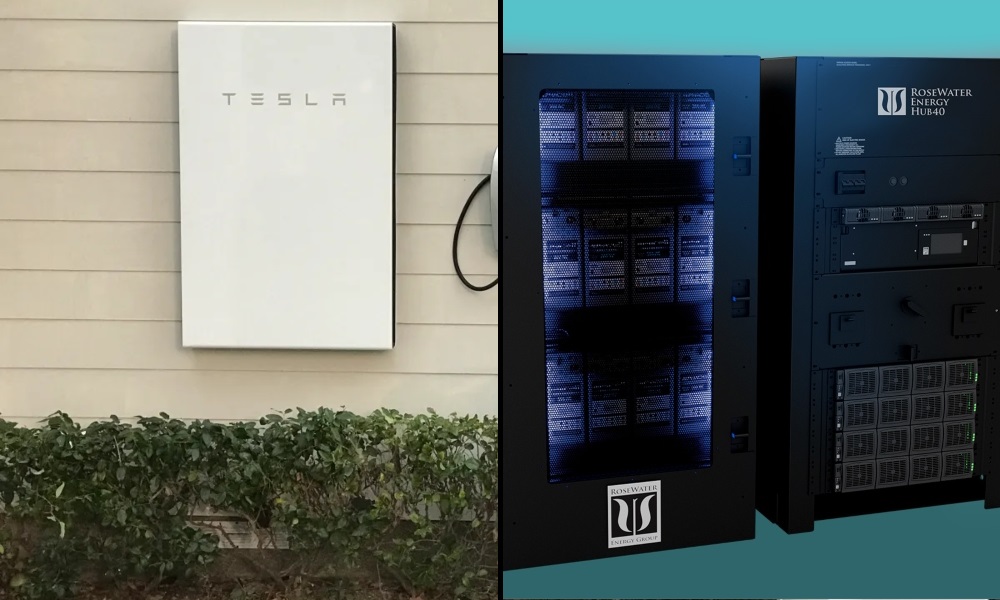About a week ago, following the debut of the Rosewater Energy Storage Hub at CEDIA Expo 2015, we got a question from one of our readers. “Didn’t the Tesla Powerwall already make this obsolete?” They asked. “I believe the Powerwall has a capacity of 10 kWh of output per unit that runs $7,000. Three of the Powerwall units would have a similar capacity and take up much less space. I am missing something here?” So to answer that question, we decided to go back and see what’s the difference between Rosewater’s Energy Storage Hub vs. the Tesla Powerwall.
What’s the Difference Between the Energy Storage Hub Versus the Powerwall?
There are some significant differences between the Energy Storage Hub and the Powerwall which we’ll list below:
- The Energy Hub has cleaner power: Unlike the Powerwall, the Energy Hub runs a double power conversion that turns AC power into DC and then back into AC, generating a perfect 60Hz sine wave for clean power.
- The Energy Hub has a faster transfer time: compared to the Powerwall, the Energy Hub turns on instantly, ensuring that vital components like computers or alarm systems don’t shut down in the brief interval that the grid goes out.
- The Energy Hub has greater capacity: There are two versions, but the big guy has 28.8 kWh of output. That will run a pretty big house, or maybe your local deli, for several hours. If you turn off the non-critical stuff, even longer. The Powerwall, in contrast, has a 10 kWh storage max and 2kW continuous draw potential.
- The Energy Hub is programmable: When it comes down to energy savings, the hub can be set up to automatically turn on during peak hours, and this is all manageable from an iPad interface.
- The Energy Hub has massive surge protection built in and it’s dual stage and serviceable.
Another less noteworthy difference between the Energy Hub and Powerwall include battery type (the Powerwall is Lithium-Ion while the Hub has options between Lithium-Ion or Nano-Carbon batteries).
There is also an interesting difference in how the Tesla utilizes solar input. Their system is designed to peak shave utilizing solar stored during the day. Ironically, this is counter-intuitive to their partner Solar City’s business model because they sell all their excess solar production back to the utility.
They could peak shave from storing power overnight, but that reduces the overall pay back because you need to pay for the overnight power. As a peak shaving device, what they offer may be adequate for many smaller homes, whereas Rosewater’s system is designed to handle larger loads and has no restrictions on cycling or draw.
The Energy Storage Hub is also between $60,000 to $80,000 MSRP depending on the system, while the Powerwall runs around $5,500 MSRP, however, that is because of the most crucial difference between them: the Powerwall is just a battery, while the Energy Storage Hub is a full-fledged system. A system would need to built around the Powerwall for it to truly compete in terms of function to the Energy Storage Hub.
Currently, there is no inverter for the Powerwall as it is a 400v system (while all the others on the market are 48v systems). It is possible they may change that in the coming months, but if they continue with that format, one would obviously need to be built around that. For the moment, there isn’t one available right now that I’m aware of.
Once you start to include that, plus all the things RoseWater does (power conditioning, lightning strike defense, zero-transfer time technology), it wouldn’t be surprising to see the price of a multi-Tesla-based system climb up to the $50k area or more, as you’d need industrial-level components such as RoseWater uses to match Rosewater’s performance.
So to the question that kicked off this examination, the Tesla product doesn’t make the RoseWater obsolete, but rather it is kind of like Tesla’s Ford Fiesta to RoseWater’s Ferrari.







